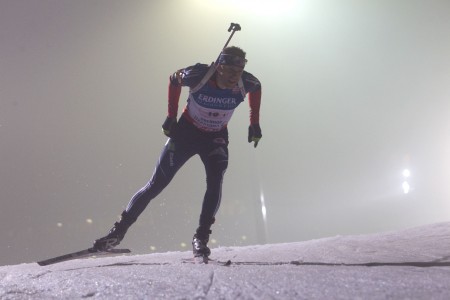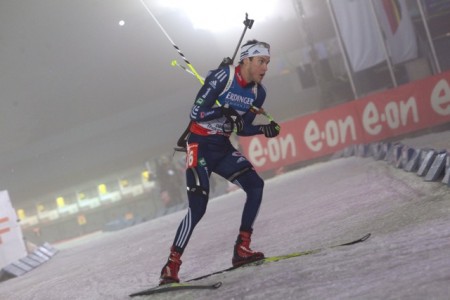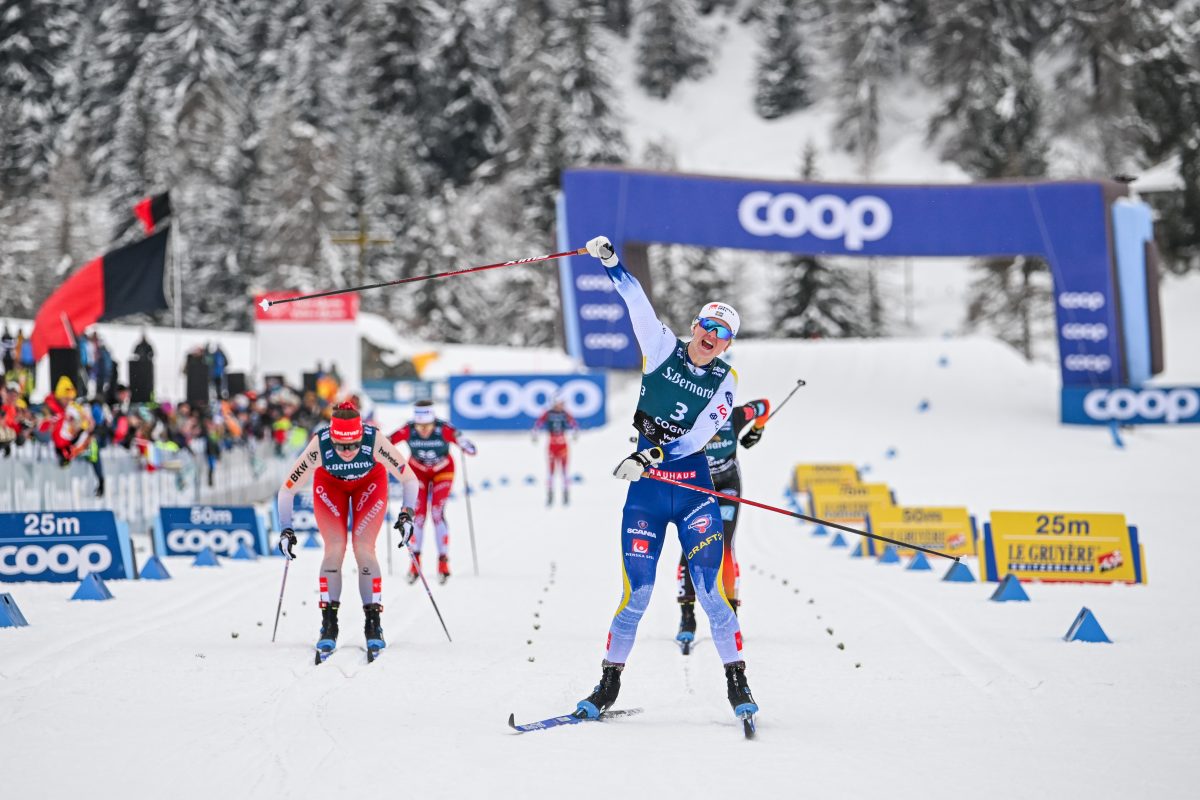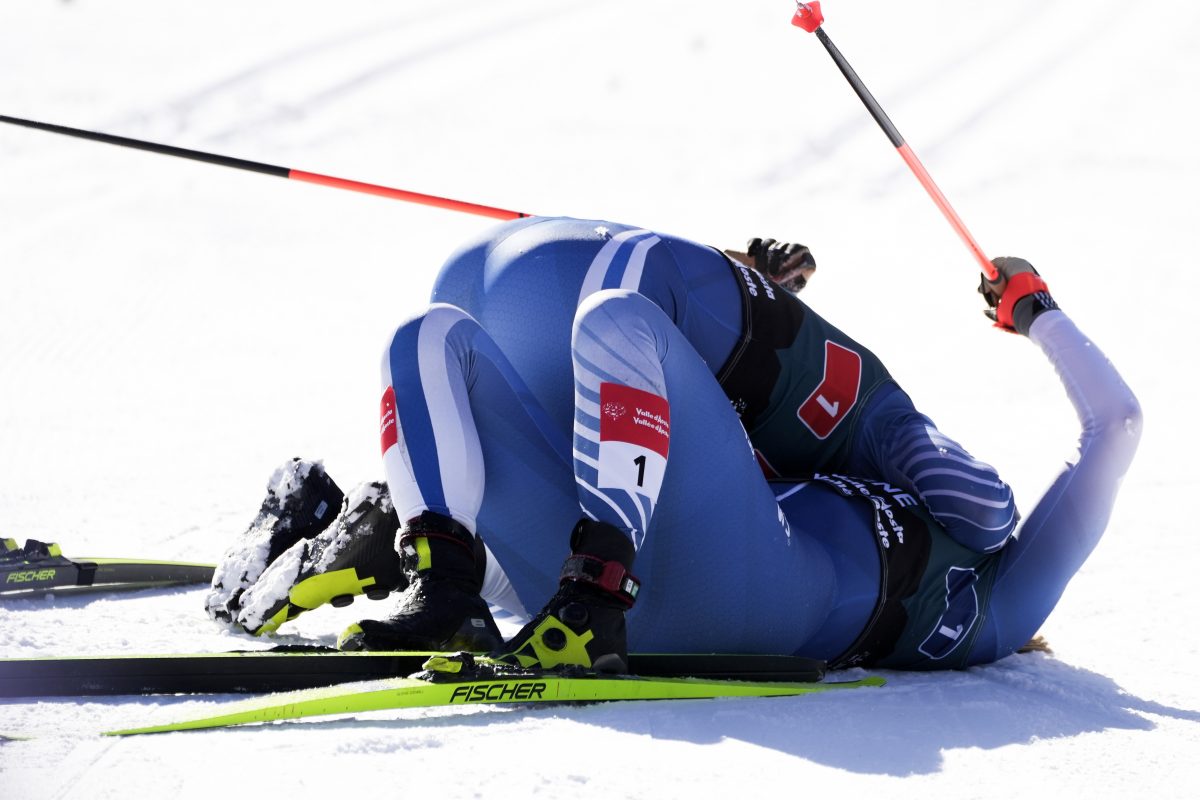
If the U.S. men skied like they had something to prove in Friday’s World Cup biathlon relay in Oberhof, Germany, that’s because they did.
“I think today we were all on a mission to show that we are much better than our 16th place from the first relay of the year,” Tim Burke wrote in an e-mail to FasterSkier. “I was really impressed how well Russ [Currier] and Leif [Nordgren] did under some big pressure, especially in front of 20,000 spectators.”
They didn’t exactly have an easy setup. Oberhof features big hills, such as the norotious Bergsteig, and terrible weather. Luckily, things had improved a bit since the women’s relay they day before, where the entire course was covered in deep slush. But only a bit.
“The course was a mix of extreme slush and really icy, hard-packed, salt-infused snow,” Lowell Bailey explained. “They salted on most of the climbs and left a lot of the rest of the course to melt into slush.”
It was a strange setup – “I guess they salted but just decided not to do the entire course,” Burke said – that Bailey was the first to have a crack at. After turning in several excellent scramble legs over the last few years, Bailey had big goals.
“Lowell was starting in the second row and was really smart and smooth, and last half of the loop he was in top five already,” U.S. head coach Per Nilsson told FasterSkier.
To do so, he had to get through a lot of traffic on the slushy, treacherous course. The character of the first loop was a little different than in your average relay, Bailey said, in that nobody wanted to lead. On the video feed, it was obvious: the field practically stopped at one point near the top of the course, jamming together and creating the potential for a tangle-up.

“The big factor was the range approach,” Bailey wrote. “On this course, the prevailing wind blows against you on the back straightway and it is a significant disadvantage to lead a group for the last 500 meters before the range. Most everyone knows that and so on the first loop, after the first 1.5km, the leaders stopped dead, jockeying for position and trying to make sure no one had to lead into the range… no one really wanted to take the bait and jump out in front because it IS such an advantage to follow someone into the shooting range.”
Coming around the last corner, Simon Eder of Austria finally took charge and led the way into the lanes, but that was after the hard work was done. Yet the wind was still putting up a fight. Bailey, for instance, was hampered by using three spares in the very first prone stage. Plenty of other men struggled on the range, and several of the favorites even headed to the penalty loop. Despite the missed targets, Bailey left in ninth.
“I just went into today knowing that Oberhof is notorious for poor shooting conditions and lots of misses,” Bailey wrote. “I wanted to shoot well and put the team in a good position. I wasn’t able to shoot as well as I would have liked, but the field did not shoot well as a whole which allowed me to stay in contention.”
The wind was constantly changing over the course of the race, with flags on the range sometimes blowing straight sideways, other times hanging dead, and often fluttering around in different directions. Through either having better conditions or reading the wind in the standing stage, Bailey was able to limit himself to one spare in standing and move up to seventh.
That cleared the stage for Burke, who started with a 30 second gap to the leading Ukrainian team.
“We started with our most experienced athletes to try to put us in a good position,” Nilsson explained of the team’s strategy. “And they did! Tim on the second leg did one of his best relays ever with smart tactic and solid skiing and shooting.”
The tactic, Burke explained, was to attack.
“I wanted to be aggressive in all areas of the race today to try and get as much of a buffer as possible to some of the other teams,” he wrote. “Today was just one of those days where that tactic worked out for me.”
It showed, as he turned in the second fastest time on the first loop, behind only Ole Einar Bjørndalen of Norway. Burke managed to hop in behind him for a time, joining Erik Lesser of Germany as well. All three cleaned the prone stage quickly with no spare rounds, adding to their cause. That put them ahead of everyone except the Ukrainians.
The group broke up, though, as Bjørndalen was having easily the best day of his season so far. He skied up to, and passed, Ukraine, while Lesser, Burke, and Evgeniy Garanichev of Russia followed in his wake a little bit farther back. They, too, caught Ukraine. Lesser cleaned in standing to move into second and Burke used a single spare to go into third.

He wasn’t done yet; as he told FasterSkier in our main race report earlier, he wasn’t sure he could catch Lesser, but he was certainly going to try. Initially it looked impossible, but Lesser faltered on the last trip up the Bergstein, later saying that he had allowed the crowd to spur him on to a too-fast pace. Burke, meanwhile, floated up the hill.
“I was actually kind of looking forward to some soft uphills because I seem to do better in those conditions, but it was also nice to have a less draining race considering we have two races this weekend,” he said of the salting on the inclines.
By the time the two came into the stadium, Burke had caught the German and was adding time – he had about two seconds at the handoff. That was the advantage he handed to Russell Currier.
“For sure a new situation for Russell, but he got into a good zone and just executed what he have been working on in the training,” Nilsson said. “He was around big names as Anton Shipulin and Arnd Peiffer. He was not as nervous as we were in the staff.”
Currier was caught by the Russian and German racers fairly quickly, but put in a good fight to ski with them, jump-skating up the Bergstein to stick on their tails. He lost a bit of ground on the downhills, but when he re-entered the stadium he was right in the thick of things.
Like Bailey, he encountered shooting conditions that were poor to say the least. Of the group, only Shipulin escaped using a single spare round. Currier used two and left with the Czech team; Peiffer required three and dropped back momentarily, before attacking on the trails. His strong skiing re-formed the group and again Currier was tucked in behind some of the sport’s strongest veterans.
“The hill had enough chemicals to make them bullet proof while the flats were were clearly neglected,” Currier said of his experience on course. “I wasn’t gaining anything on the flats and transitions and had to work harder in some parts to stay with the group. Thankfully, the climbs were solid and gave me a chance to catch back up with the group if need be.”
Slowly and deliberately knocking down his targets in standing, Currier still needed a spare. He avoided penalty loops or more spares, but the speed by the other racers was significantly higher and he left the range in no-mans-land.
“Standing was harder than I thought it would be,” Currier told FasterSkier. “There wasn’t too much wind, but setting up on point four really never helps the pressure factor. If there is anything I did right on the shooting range yesterday it was the fact that I absolutely no idea what was going on around me. In the past I’ve had the bad habit of listening to how the others around me are shooting and then doing the math in my head. Yesterday I was pretty much by myself.”
While Peiffer and Shipulin charged ahead, nearly catching Norway’s Erlend Bjøntegaard, Currier was left on his own.He fought gamely, turning in the third-fastest ski time for his leg. But the gap had returned to 30 seconds by the time he handed off to Leif Nordgren.
“After his race we were still in a good place at fifth,” Nilsson wrote. “Russell is pretty new in the relay but his confidence is growing for every time. Hochfilzen was also good for him.”
That meant that Nordgren, too, was left to his own devices.
“Really I was just focused on my own race,” he told FasterSkier. “On the first loop I wasn’t thinking too much about the pack ahead of me, I knew I wouldn’t see them till the shooting range, but I knew there were some fast guys coming behind me, so I was thinking more about them. I pushed pretty hard that first loop because of that thought.”
He hit the range while several of the men ahead of him were still shooting; Dimitry Malyshko of Russia used one spare, Florian Graf of Germany two, and Andriy Deryzemlya of Ukraine three. But Nordgren couldn’t capitalize, needing all of his spare rounds to clean the targets.
“Prone was the thing that held me back the most,” he wrote in an e-mail. “When I entered the range I saw some of the others in front had some extras, I think I focused on that a little too much. I made it out alive though, but after that I was off in no mans land even more. The second and third loops I was able to ski pretty relaxed, no one was close either ahead or behind.”
Perhaps that relaxation helped, as Nordgren flew through his standing stage with nary a worry. By the time he crossed the line, still in fifth and 1:44 behind the winning Russian team, he was smiling.
“Not too bad of a night!” he wrote. “Race went alright for me, it wasn’t anything spectacular, but it was good enough.”
Certainly an improvement on that 16th-place finish Burke had been so eager to put behind him. The strong team result highlights Nilsson’s desire to have his racers improve with each competition, and be ready to peak at World Championships in Nove Mesto, Czech Republic in the middle of February. While there had been some good results in pre-Christmas racing, notably a third place finish for Burke, many of the Americans hadn’t been performing at their potential. But it hadn’t worried Nilsson.
“The highlight is for sure Nove Mesto,” he explained. “Tim had a cold leading into the first World Cup and Lowell broke his toe in Hochfilzen, so it was not optimal either. Russell is normally a slow starter also, and need some more races to get into a relaxed race mode. For Leif we planned to just go to World Cups one and two, and then home to Minnesota for a good training block.”
Bailey reported that the broken toe definitely wasn’t better, but that he hoped in about two week’s time the incident, where he accidentally kicked the leg of a bed in his hotel room, would be behind him.
“The toe has been really annoying and frustrating at times,” he wrote. “I couldn’t really afford to take too much time off of it to let it heal and I think this has definitely prolonged the recovery. I still can’t put my foot in a normal shoe or a normal ski boot – I have a pair of boots that I pushed out so that there is more room for that toe. It helps quite a bit and I’m able to skate on it without too much pain. But it will be nice when it finally heals completely.”
As for Nordgren, he said he was hugely helped by the longer Christmas break, where he was able to train and also jumped in a race at IBU Cup trials, where he won the mass start by 30 seconds over Bill Bowler.
“I was able to get a really good few weeks of training in before Christmas since I skipped the Pokljuka World Cup,” Nordgren said. “That had been a plan for a while, to do the first IBU Cup, and skip Pokljuka, that way I could get in a whole trimester and a solid training block as well. My shooting had been pretty dismal up to that point, so it was a good opportunity to work some things out.”
Nilsson said that the relay was a good confidence boost for all, and USBA President Max Cobb agreed.
“Today’s result signifies several things to me,” he wrote in an e-mail to FasterSkier. “Tim Burke put in a particularly strong performance both skiing and on the range and though Lowell Bailey struggled on the range he’s able to compete with anyone out there, skiing back into the race after needing three extra rounds in prone. The two younger athletes, Russell Currier and Leif Nordgren, put in disciplined performances in very challenging conditions, skiing among some of the top biathletes in the world. That gives me a lot of hope for the future both this season and for years to come.”
Nordgren seemed to embody that sentiment perfectly.
“I’m pretty excited for this next trimester,” he wrote. “ I’m excited to be back in Europe now and racing again!”
Chelsea Little
Chelsea Little is FasterSkier's Editor-At-Large. A former racer at Ford Sayre, Dartmouth College and the Craftsbury Green Racing Project, she is a PhD candidate in aquatic ecology in the @Altermatt_lab at Eawag, the Swiss Federal Institute of Aquatic Science and Technology in Zurich, Switzerland. You can follow her on twitter @ChelskiLittle.



